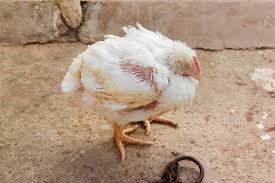Infectious bursal disease (IBD), also known as Gumboro disease, is a viral infection that affects young chickens. It’s highly contagious and can cause immunosuppression.
Species affected: Mainly chickens, serotype 2 also occurs in turkeys and ducks.
Age affected: Young birds (2-16 weeks).
Causes: Infectious bursal disease virus is a birnavirus. It is highly stable and resistant to many physical and chemical agents. It is highly contagious and is spread by contaminated faeces, water and feed. It can also be carried by vectors such as darkling beetles and rats.
READ MORE: Sudden Death Syndrome in Broiler
Symptoms:
- Elevated body temperature (111ºF)
- Watery diarrhoea
- Anorexia
- Depression
- Ruffled feathers
- Head tremors
- Sleepiness and lameness can occur
- Morbidity approaches 80% in Isa brown and 50% in broilers. Hypervirulent strains occur in many parts of the world and can cause up to 100% morbidity and 80% mortality in laying hens. Normal mortality is not more than 40% in laying hens and 20% in less virulent strains in broilers. The virus is immunosuppressive
Treatment
There’s no specific treatment for IBD, but support therapies can help.
Vitamin and electrolyte supplements can help.
Antibiotics can treat secondary bacterial infections.
Prevention
The main method of control is vaccinating parent chickens.
The chicks receive maternal antibodies from the vaccinated parents.
READ MORE: Gangrenous Dermatitis in Poultry
Other effects
- IBD can lead to lymphoid depletion in the bursa of Fabricius.
- This can result in a significant depression of humoral antibody responses.
- This can promote secondary infections, such as E. coli, salmonella, mycoplasma, coccidia, and Marek’s disease.
IBD in other birds
Although turkeys, ducks, guinea fowl, pheasants, and ostriches may be infected, clinical disease occurs solely in chickens.
Click HERE to join our WhatsApp group

